Gallstones vs. Kidney Stones: Key Differences Explained


Intro
When it comes to our health, understanding the nuances of different medical conditions is crucial. Among these conditions, gallstones and kidney stones are often discussed yet frequently confused. While both can lead to significant discomfort and other health complications, they stem from entirely different processes within the body. The essence of this article lies in unraveling the complexities surrounding these two ailments, laying bare their distinctions in formation, symptoms, treatments, and preventative measures. This comprehensive guide aims not just to inform but to clarify the unique health implications that each presents.
In delving deeper, we will analyze the risk factors predisposed to each condition, their respective diagnostic methods, and what preventative steps can be taken to avoid these pesky stones altogether. By the time you finish this exploration, you’ll be equipped with a clearer grasp of how gallstones differ from kidney stones, empowering your health decisions.
Research Overview
Summary of Key Findings
Through the gathered insights, it becomes evident that understanding the formation and composition of gallstones and kidney stones is fundamental in delineating the two. Gallstones typically form in the gallbladder from bile components, while kidney stones crystallize from waste products in the kidneys.
Notably, the symptoms also vary significantly.
- Gallstone symptoms may include:
- Kidney stone symptoms tend to manifest as:
- Abdominal pain, particularly after eating fatty foods
- Nausea or vomiting
- Jaundice (in severe cases)
- Intense pain in the back or side
- Blood in urine
- Frequent urination, often with a burning sensation
Understanding these symptoms can greatly aid in early diagnosis and treatment.
Background and Context
The prevalence of gallstones and kidney stones means that many individuals will face these ailments at some juncture in their lives. Approximately 10% of people will deal with gallstones, while kidney stones tend to occur in about 12% of the population, and the chances can be higher among those who have family histories of the conditions.
Interestingly, lifestyle choices play a significant role.
- A diet high in fat increases gallstone risk.
- Dehydration is a common trigger for kidney stones.
The connection between dietary habits and these conditions emphasizes the need for awareness when it comes to food choices. Grasping the fundamental differences between these conditions allows individuals not only to seek appropriate treatment but also to implement effective preventive measures. This is not just a matter of academic curiosity; it can lead to improved overall health outcomes for many.
Prologue to Gallstones and Kidney Stones
The distinction between gallstones and kidney stones isn't just a matter of semantics; it can dramatically impact diagnosis and treatment. Understanding these two conditions is imperative for both medical professionals and patients alike. These ailments frequently lead to discomfort, complications, and sometimes urgent medical situations, making it crucial to distinguish between the two.
When we talk about gallstones, we enter a realm that involves the gastrointestinal system, with implications for bile production and digestion. Conversely, kidney stones relate to the urinary system, affecting how the body filters waste and maintains homeostasis. Both conditions arise from different biological processes, which is essential for appropriate management.
This section aims to lay the groundwork by providing clear definitions and exploring the prevalence and demographics associated with each condition. This clarity will help readers grasp not only the significance of the topic but also the consequences of misdiagnosis or misunderstanding.
Defining Gallstones and Kidney Stones
Gallstones are solid particles that form in the gallbladder, typically made up of cholesterol or bilirubin. They can vary in size and may be as small as a grain of sand or as large as a golf ball. Essentially, these stones may cause issues if they block bile ducts, leading to pain and potential complications.
In contrast, kidney stones are hard deposits that form in the kidneys from minerals and salts. They can be tiny or can grow into large masses, often causing severe pain as they move through the urinary tract. Unlike gallstones, kidney stones can be categorized by their composition, such as calcium oxalate or uric acid stones.
Both these conditions present their own set of challenges and clinical implications, depending on various factors including size, composition, and whether they obstruct normal bodily functions.
Prevalence and Demographics
The prevalence of gallstones and kidney stones varies by geography, age, and underlying health conditions. Gallstones are especially common among women, particularly those over 40, with a significant relationship to obesity and rapid weight loss. Statistics show that almost 10-20% of adults in developed countries may experience gallstones at some point in their lives, with factors like sedentary lifestyle playing a key part.
On the other hand, kidney stones are becoming increasingly prevalent. It is said that about 1 in 11 people will experience a kidney stone in their lifetime. They tend to occur more frequently in men compared to women. The demographic is shifting, with younger individuals also presenting with stones, often linked to dietary habits, obesity, and dehydration.
"Understanding the statistics surrounding these conditions can be early indicators of risk and enables preventive strategies to be laid out during initial patient assessments."
In summary, both conditions are significant in public health dialogues and warrant attention due to their impact on individuals and healthcare systems.
Formation of Gallstones
Understanding the formation of gallstones is paramount in differentiating them from kidney stones. Not only does it provide insights into the physiological and biochemical processes involved, but recognizing this formation can lead to more effective management and treatment options. Gallstones, essentially solid particles that form in the bile, result from a combination of imbalances in bile composition, excessive cholesterol, and various digestive conditions. Managing factors contributing to gallstone formation can significantly impact overall health and aid in preventing complications down the line.
Biochemical Processes Involved
The formation of gallstones is influenced primarily by the concentration of substances within bile. Bile, produced by the liver, aids in breaking down fats during digestion. If the balance of bile salts, cholesterol, and bilirubin shifts, it may lead to an increase in cholesterol crystallization—this crystallization is one of the key processes in gallstone formation.
Key Factors include:
- Cholesterol Saturation: When too much cholesterol is present, the bile becomes supersaturated, leading to the formation of cholesterol crystals.
- Biliary Salt Concentration: Bile salts are necessary for emulsifying fats; a deficiency can contribute to the precipitation of cholesterol.
- Bilirubin Levels: Excess bilirubin, often resulting from hemolysis or liver diseases, can cause pigment stone formation due to its interaction with bile.
It’s also essential to note that gallbladder motility plays a key role. If the gallbladder does not empty efficiently, bile can become concentrated, promoting stone formation.
Types of Gallstones
Gallstones can be categorized into two main types based on their composition: cholesterol gallstones and pigment gallstones. Understanding these distinctions not only aids in diagnosis but also helps in crafting tailored treatment plans.
Cholesterol Gallstones
Cholesterol gallstones account for approximately 80% of gallstones, which makes them a significant focus in both clinical and research contexts. These stones typically form when there’s an excess of cholesterol in the bile. They can be yellow-green in color and vary in size, some being as small as a grain of sand, while others can be quite large.
Key Characteristics:
- Composition: Made primarily from crystallized cholesterol.
- Risk Factors: Obesity, certain diets high in fats, and rapid weight loss increase cholesterol stone formation.
The significance of cholesterol gallstones in this article is not just their prevalence but their implications for treatment. Dietary modifications and medications can effectively manage them. Moreover, understanding their formation is crucial when discussing preventive measures.
Pigment Gallstones
Pigment gallstones, on the other hand, are less common but equally important to recognize. They are typically dark brown or black and form when there is an excess of bilirubin. Conditions like cirrhosis, biliary tract infections, and hemolytic anemias can trigger their formation.
Key Characteristics:
- Composition: Primarily made up of bilirubin and calcium salts.
- Associated Conditions: More prevalent in individuals with liver disease or certain blood disorders.
Pigment gallstones contribute to a different set of complications than cholesterol stones, often necessitating unique approaches to management. Understanding these differences is critical for healthcare providers and patients alike.
"Differentiating between types of gallstones can significantly influence treatment strategies and patient outcomes."
Formation of Kidney Stones
The formation of kidney stones is a critical aspect of understanding urological health. This section dives into how these nefarious little crystals are created in the kidneys, leading to a painful experience for many individuals. Grasping the mechanics behind kidney stones not only aids in recognizing symptoms but also helps in identifying preventive measures and treatment options. By shining a light on the formation process, we can better appreciate the unique nature of each type of stone and their implications on health.
Mechanisms Leading to Kidney Stone Formation
The creation of kidney stones often involves a series of complex processes that revolve around the concentration of certain substances in the urine. When the urine becomes supersaturated with minerals and acids, such as calcium, oxalate, and uric acid, conditions become ripe for stone formation. A classic instance is when the kidneys filter these substances, but if the urinary system doesn’t flush them out effectively, they can crystallize.
Several key factors contribute to this crystallization process:
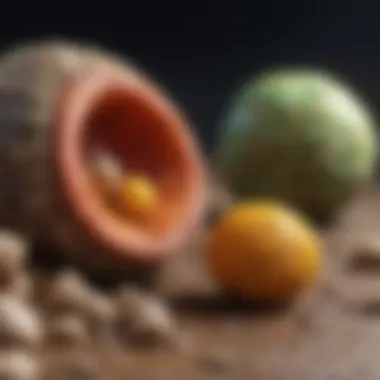
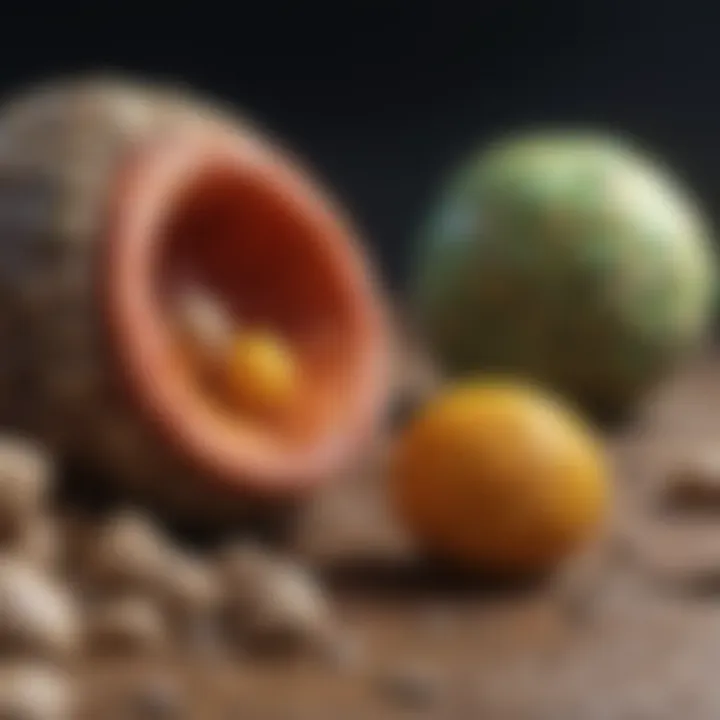
- Low Fluid Intake: Not drinking enough water results in concentrated urine, increasing the chances of stone formation.
- Dietary Influences: High intake of protein, sodium, and sugar can alter the urine's pH and mineral composition.
- Metabolic Disorders: Conditions like hypercalcemia or hyperuricemia lead to an increased chance of crystallization.
Understanding these mechanisms is essential for anyone looking to mitigate their risk of kidney stones.
Common Types of Kidney Stones
Kidney stones aren’t a one-size-fits-all issue; several distinct types exist, each with their own characteristics and implications. This section highlights the primary types of kidney stones and what sets them apart.
Calcium Stones
Calcium stones are the most prevalent type of kidney stones, accounting for roughly 80% of cases. These stones primarily form when calcium in the urine crystallizes due to high concentrations of calcium oxalate or calcium phosphate.
They are often influenced by dietary habits, particularly excess calcium or oxalate-rich foods like spinach and nuts. On a positive note, awareness of this can lead individuals to make informed dietary choices to manage risk. However, high calcium intake from supplements can paradoxically increase stone formation. The flexible yet troublesome nature of calcium stones makes them a significant focus in understanding kidney health and prevention strategies.
Struvite Stones
Struvite stones are less common but can be quite problematic. These stones often develop in response to infections in the urinary tract, particularly those caused by bacteria that produce urease, leading to highly alkaline urine.
This should signal a red flag for anyone, as they can grow quite large and obstruct the urinary tract. Regular checkups and immediate treatment of urinary infections can be beneficial, thus working towards prevention.
Uric Acid Stones
Uric acid stones emerge from a high concentration of uric acid in the urine, often linked to conditions such as gout or high-protein diets. They usually tend to form when urine is overly acidic, declining dietary or metabolic shifts could be sensible preventive strategies.
One characteristic of uric acid stones is that they can sometimes be dissolved through dietary changes and medications. Thus, they present a somewhat unique advantage in terms of management compared to other stone types.
Cystine Stones
Cystine stones are the rarest type and stem from a genetic disorder known as cystinuria, where the amino acid cystine leaks into the urine. These stones tend to be large, and like their struvite counterparts, they can cause significant complications when they obstruct urine flow. Prevention through increased fluid intake and medication could stop their formation, but managing a genetic predisposition adds complexity.
Understanding these distinct types of kidney stones and their formation mechanisms lays the groundwork for tailored approaches in treatment and prevention. By familiarizing ourselves with these aspects, we can empower individuals to maintain a healthier lifestyle while mitigating the risk of kidney stones.
Comparison of Symptoms
Understanding the symptoms of gallstones and kidney stones is crucial for diagnosing and managing these conditions. Knowing how each condition presents itself can lead to earlier treatment, minimizing the risk of complications. Symptoms can often manifest significantly and are usually the first indicator prompting an individual to seek medical attention. Moreover, while some overlap exists between the symptomatology of gallstones and kidney stones, recognizing the differences can guide treatment pathways and lifestyle changes. This section will dig into the symptom profiles of both gallstones and kidney stones, emphasizing distinctive experiences.
Symptomatology of Gallstones
Biliary Colic
Biliary colic refers to the pain that arises from the obstruction of bile ducts, often due to gallstones. This type of pain is typically characterized as a sudden, severe episode often occurring after a meal high in fat. Patients describe it as a cramping sensation in the abdomen, which can move toward the right shoulder or back.
Key Characteristic: One significant aspect of biliary colic is its cyclic nature; it tends to arise suddenly and might last anywhere between 30 minutes to several hours. The intensity can vary and may lead to serious discomfort. This feature allows it to serve as a classic sign of gallbladder issues.
Benefits/Drawbacks: The identification of biliary colic can be a beneficial key for healthcare providers, as it could prompt further investigation. The downside, however, is that since the pain can be intermittent, some may delay seeking help, thinking it will resolve.
Cholecystitis
Cholecystitis is the inflammation of the gallbladder and often follows an episode of biliary colic. Symptoms can escalate to include fever, continuous abdominal pain, and sometimes jaundice. It’s typically triggered by the presence of gallstones that irritate the gallbladder lining.
Key Characteristic: Continuous pain rather than episodic bouts can alert both the patient and healthcare providers that a more serious condition is developing.
Benefits/Drawbacks: Cholecystitis calls for immediate medical attention and often requires surgical intervention, making its recognition critical for the prevention of severe complications.
Pancreatitis
An additional complication related to gallstones is pancreatitis, specifically when stones block the pancreatic duct. This condition presents with severe abdominal pain, nausea, vomiting, and fever.
Key Characteristic: The pain in pancreatitis can radiate to the back and can persist for days, offering a different experience than simple biliary colic.
Benefits/Drawbacks: Recognizing pancreatitis is vital, as it may necessitate hospital admission and aggressive management. However, complications can arise if gallstones are left unchecked.
Symptomatology of Kidney Stones
Renal Colic
Renal colic is described as one of the most intense types of pain that individuals may experience. It often occurs as stones pass through the urinary tract, causing sharp, cramping agony that can vary between the flanks and lower abdomen.
Key Characteristic: The hallmark of renal colic is its sudden onset and extreme intensity, often described as wave-like due to the movement of stones.
Benefits/Drawbacks: The ability to recognize renal colic can lead to timely intervention, alleviating the patient from extreme discomfort. On the flip side, its severity might lead to immediate urgency that can cause some individuals to panic unnecessarily.
Hematuria
This symptom refers specifically to blood in the urine, a common occurrence when stones scratch the lining of the urinary tract. Patients with hematuria might notice a reddish or brownish tint to their urine, indicating irritation and damage.
Key Characteristic: The presence of hematuria often signifies that the stones are causing more than mild irritation, escalating the need for medical evaluation.
Benefits/Drawbacks: While hematuria can be a key indicator of kidney stones, it can also point to other urinary pathways issues, prompting a comprehensive investigation.
Nausea and Vomiting
Kidney stones frequently cause nausea and vomiting, which can stem from the pain and the body's response to severe discomfort. This can add to dehydration risk, exacerbating the situation.
Key Characteristic: These symptoms often accompany renal colic, highlighting the systemic nature of the pain.
Benefits/Drawbacks: Recognizing that nausea and vomiting can also be a part of the renal stone experience might assist healthcare professionals in better addressing patient needs, though it can lead to misunderstanding the underlying issue if not properly assessed.
Diagnostic Techniques
When it comes to identifying gallstones and kidney stones, diagnostic techniques play a pivotal role. Understanding the available methods helps healthcare professionals accurately diagnose these conditions and determine the most appropriate course of action. The choice of diagnostic method can significantly impact the treatment process, leading to quicker relief and better patient outcomes. This section examines the imaging methods used to reveal the presence and nature of these stones.
Imaging Methods for Gallstones
Ultrasound
Ultrasound imaging stands out in the landscape of diagnostic techniques for gallstones. This method leverages sound waves to create images of the gallbladder and surrounding arteries, making it a non-invasive choice. One of its key characteristics is the ability to visualize gallstones clearly without the use of radiation. This makes it especially beneficial for sensitive populations such as pregnant women.
The unique feature of ultrasound lies in its portability and the immediacy of the results. Unlike more complex scans, it can often be performed quickly at the bedside, allowing healthcare providers to make prompt decisions. However, it does have limitations, such as difficulty visualizing stones in patients who are overweight or those with significant bowel gas, which may obscure the view. Despite these downsides, its safety and efficacy make ultrasound a popular option for initial gallstone assessment.
CT Scan
The CT scan is another cornerstone in diagnosing gallstones due to its high resolution and ability to provide comprehensive images of internal structures. This imaging method utilizes X-rays to create cross-sectional images, allowing practitioners to assess not just the gallbladder but also surrounding organs.
One notable characteristic of CT scans is their speed—results are often available very quickly, which can be critical in emergencies where time is of the essence. The detailed images from a CT scan can also help detect complications related to gallstones, such as inflammation or perforation. However, the exposure to radiation is a significant consideration. While the benefits usually outweigh the risks, the need to minimize radiation exposure, especially in young patients or those requiring multiple scans over time, is paramount.
HIDA Scan
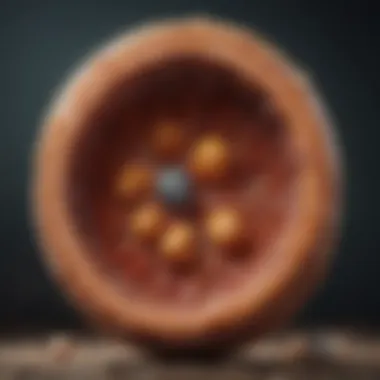
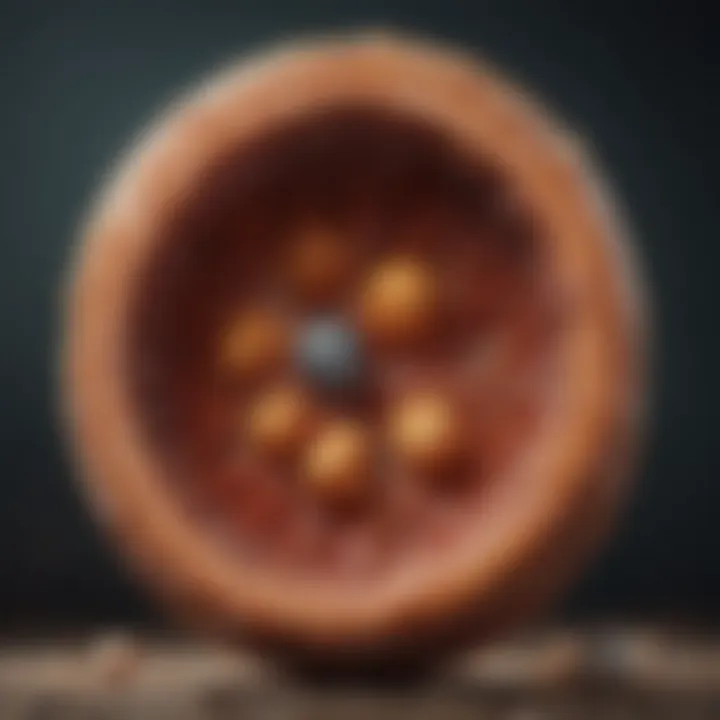
HIDA scan, or hepatobiliary iminodiacetic acid scan, excels in assessing the functionality of the gallbladder. This technique uses a radioactive tracer to visualize the flow of bile and can identify whether the gallbladder is functioning properly.
A key characteristic of the HIDA scan is its ability to pinpoint not just the presence of gallstones but also any dysfunction in gallbladder operation, providing a broader scope for potential issues. The unique feature of this scan lies in its functional assessment, which can guide treatment decisions more effectively than imaging methods that only show the stones’ presence. On the downside, the use of radioactive tracer raises concerns about safety, especially for vulnerable populations. Still, its detailed insight into gallbladder health underscores its value in comprehensive diagnostic strategies.
Imaging Methods for Kidney Stones
X-rays
When focusing on kidney stones, X-rays serve as a foundational imaging technique. They are particularly useful in identifying calcium-based stones, which are the most common type.
One of the most recognized features of X-rays is their rapidity—they can produce results almost immediately. However, they might not detect all types of kidney stones, especially if they are made of materials that don’t show up well on X-rays, such as uric acid stones. While they are a cost-effective option, their limitations necessitate additional testing in uncertain cases.
CT Urogram
The CT urogram is a more advanced imaging method that provides a detailed look at the urinary tract and is highly effective in detecting kidney stones. It involves a contrast dye that enhances the visibility of the ureters, kidneys, and bladder.
The key characteristic of the CT urogram is its superior detail compared to standard X-rays or even a CT scan. This method can detect stones as small as 1-2 mm in size, making it invaluable for comprehensive evaluations. The drawback, however, is the radiation exposure along with the potential risk associated with the use of contrast material, including allergic reactions. Nevertheless, the diagnostic accuracy offered by CT urograms often outweighs these risks, making it a favorite among urologists.
Ultrasound
Ultrasound is also used in the context of kidney stones. Its non-invasive nature and lack of radiation make it an appealing choice, particularly for those who need repeated assessments or are sensitive to radiation.
Its characteristic real-time imaging allows healthcare providers to monitor kidney stones during treatment. A unique feature of ultrasound is its ability to visualize kidney stones in pregnant women safely. However, it may not be as effective in detecting all types of stones or very small ones, limiting its diagnostic range. Still, its utility in certain scenarios cannot be understated, balancing safety with effective monitoring.
In summary, the choice of imaging method is critical to obtaining accurate diagnostics of gallstones and kidney stones. Each method has its strengths and weaknesses, and often, a combination of techniques is employed to create a full picture that informs treatment.
Treatment Options
Understanding treatment options for both gallstones and kidney stones is pivotal, as it informs both individuals and healthcare professionals about effective management strategies. It is vital to note that treatment decisions are influenced by various factors, including the severity of symptoms, stone size, and overall health. By delving into specific treatments, we can illuminate the unique approaches for each condition and underscore the importance of tailored care.
Managing Gallstones
Watchful Waiting
Watchful waiting is a strategy often adopted when gallstones are asymptomatic. This approach is based on the principle that not every gallstone requires immediate intervention. It allows patients to avoid unnecessary procedures, which can be beneficial especially for those who may not exhibit any significant symptoms.
One key characteristic of watchful waiting is the focus on monitoring. Patients are regularly evaluated to determine if their condition changes. It's often a popular choice for those who have small stones or minimal discomfort. This unique feature of letting nature take its course helps avoid the complications associated with surgical procedures.
However, this approach does come with its disadvantages. There is a risk of sudden changes, like the onset of severe pain or complications, which could require an urgent surgical intervention. Therefore, ongoing assessments are crucial.
Surgical Interventions
When symptoms of gallstones become acute, surgical intervention may be necessary. The most common procedure is cholecystectomy, or the removal of the gallbladder. This approach is beneficial because it removes the source of the problem and can drastically reduce the chances of future complications.
A key characteristic of surgical interventions is their efficiency in pain relief and resolution of symptoms. Many patients experience significant improvements shortly after the surgery. The unique feature of this method is that it is often performed laparoscopically, which minimizes recovery time and pain for the patient.
However, like any surgical procedure, there are risks associated, such as infection or bleeding. Additionally, removing the gallbladder can lead to changes in digestion that some may find uncomfortable. Understanding these factors helps patients make informed decisions about their care.
Medications
In some cases, medications can be an effective treatment for gallstones, especially for cholesterol gallstones. Bile acid pills can help dissolve these types of stones, providing a non-invasive alternative to surgery. This option is beneficial for patients who may not be ideal candidates for surgical interventions due to other health concerns.
The key characteristic of medication as a treatment option is its non-invasive nature. It offers a chance to manage gallstones without the need for surgical recovery. The unique feature here is the potential for gradual stone dissolution, which can be appealing for many patients.
However, medications may take a long time to be effective and might not work for everyone. There's also a possibility of recurrence after stopping the medications. Therefore, discussions with healthcare providers about the most suitable options are crucial.
Managing Kidney Stones
Fluid Intake
Hydration plays a significant role in preventing and managing kidney stones. Increased fluid intake helps dilute substances in the urine that can form stones. It’s generally recommended to aim for at least 2-3 liters of water per day, depending on individual health circumstances and climate conditions.
A key characteristic of emphasizing fluid intake is its simplicity and effectiveness. Many people can implement this change in their daily routine with minimal effort. The unique feature is that maintaining proper hydration can often prevent the formation of new stones, which can be seen as a proactive approach to kidney health.
Nonetheless, one disadvantage is that individuals who may have difficulty accessing clean water or have other health concerns might find this difficult to manage. It’s essential to assess individual needs before determining hydration goals.
Medications
For kidney stones, medications play a critical role in alleviating pain and managing symptoms. Over-the-counter pain relievers, such as ibuprofen or acetaminophen, can provide relief during the passage of stones. Additionally, medications may also help to relax the ureter and facilitate stone passage.
The key characteristic of using medications in managing kidney stones is their ability to control pain effectively. They allow individuals to cope while seeking further treatment options. The unique feature of these medications is their rapid action profile, particularly during acute episodes of pain.
However, it's worth noting that they only address symptoms and do not eliminate stones. For individuals with recurrent kidney stones, medications alone may not be sufficient.
Surgical Procedures
In cases where kidney stones are large or cause significant obstruction, surgical procedures may be necessary. Techniques such as ureteroscopy, shock wave lithotripsy, or percutaneous nephrolithotomy can effectively remove or break down the stones.
The key characteristic of surgical procedures is their ability to provide immediate relief and resolve acute complications. Patients often experience significant improvements after these interventions. The unique feature is the use of advanced technology that can allow for minimally invasive options, contributing to shorter recovery times.
Still, there are risks involved, including potential kidney damage, infection, or complications from anesthesia. Weighing these risks against the potential benefits is vital for informed decision-making.
Understanding these treatment options not only educates patients but also empowers them to make proactive choices in managing their health conditions.
Prevention Strategies
Preventing gallstones and kidney stones is vital to maintaining one's overall health. By taking proactive measures, individuals can significantly reduce their risk of these painful conditions. Understanding the significance of prevention can help individuals make informed dietary and lifestyle choices that promote kidney and gallbladder health, ultimately avoiding potential complications down the line.
Preventing Gallstones
Dietary Modifications
Eating habits play a crucial role in preventing gallstones. A well-balanced diet, rich in fruits, vegetables, fiber, and healthy fats, can mitigate the risk. This dietary modification can help regulate cholesterol levels in the bile, minimizing the chance of stone formation. One key characteristic of dietary alterations is incorporating more plant-based foods, which are generally low in calories and high in nutrients.
The unique facet of dietary modifications is how they can cater to individual preferences. For example, someone can opt for avocados and nuts, which provide healthy unsaturated fats. However, this doesn’t mean throwing caution to the wind; overindulgence in any food, even healthy ones, can lead to weight gain and contribute to gallstone risk. Therefore, moderation and balance are essential features of dietary modifications, making them a popular focal point in the prevention strategies discussed in this article.
Maintaining Healthy Weight
Keeping a healthy weight is another effective way to prevent gallstones. Overweight individuals are at a higher risk for stone formation, primarily due to excess cholesterol. A significant aspect of maintaining a healthy weight is understanding that it is not just about the number on the scale, but also about body composition and fat distribution.
The critical characteristic of this prevention method is its impact on one's overall health, not just gallbladder concerns. Maintaining a healthy weight is beneficial because it lowers the chances of developing other related health issues, such as diabetes or heart disease. It is worthwhile to note that drastic weight loss can also increase the risk of gallstones, so it's better to approach this gradually. This unique feature solidifies why maintaining a healthy weight is fundamental in the preventive framework of this article.
Preventing Kidney Stones
Increasing Fluid Intake
Hydration is pivotal for kidney health and crucial in preventing kidney stones. Consuming ample amounts of water helps dilute the substances in urine that lead to stones. A specific aspect of increasing fluid intake is the common recommendation to drink at least eight 8-ounce glasses of water daily, commonly known as the "8x8 rule". This straightforward guideline is practical for many.
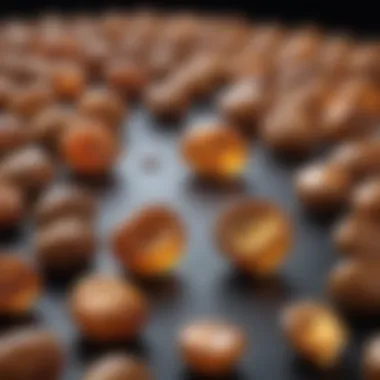
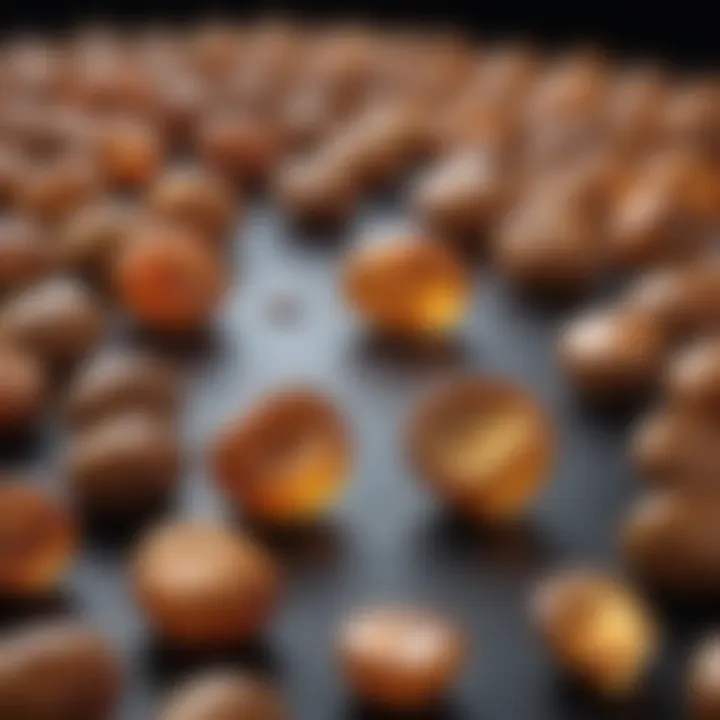
A key characteristic of this preventive measure is its accessibility. Water is readily available and comes with no calories, making it an easy choice. However, individuals should also be cautious about excessive consumption of sugary or caffeinated drinks, as they might have the opposite effects. The unique feature of increasing fluid intake is not only its effectiveness in prevention but also how it simultaneously promotes overall health, thus making it a standout strategy in our discussion.
Avoiding High-Oxalate Foods
High-oxalate foods can contribute significantly to the formation of certain types of kidney stones, especially calcium oxalate stones. Foods such as spinach, beets, and almonds are particularly high in oxalates. Understanding this specific dietary component can be game-changing for individuals at risk. The key trait of avoiding these foods is that it is a preventive strategy that doesn’t require major lifestyle upheaval; rather, it’s about making informed food choices.
The unique character of this approach is the emphasis on moderation rather than elimination. For instance, enjoying a small portion of high-oxalate foods occasionally may not cause harm while balancing it with low-oxalate options like lettuce or apples. This balanced approach to dietary management allows for flexibility without complete deprivation. Such insight is what enhances the understanding of prevention strategies discussed in this comprehensive guide.
"Prevention is always better than cure." Understanding and implementing these strategies can save you from the acute pain of both gallstones and kidney stones.
Understanding Complications
Understanding the complications arising from gallstones and kidney stones is crucial for developing effective management strategies. Comprehending these complications not only aids medical professionals in diagnosing and treating these conditions but also empowers patients with knowledge about the potential risks they face. By diving into the various complications linked to each ailment, we gather valuable insights about how these issues can impact overall health and wellbeing. This section aims to shed light on complications like infections, obstructions, and damage to organs to highlight the broader implications of gallstones and kidney stones on patient health.
Complications of Gallstones
Cholecystitis
Cholecystitis, which is the inflammation of the gallbladder, represents a significant complication of gallstones. When gallstones obstruct the cystic duct, they can trigger an acute inflammatory response. This is a serious condition often requiring prompt medical attention. The key characteristic of cholecystitis is severe abdominal pain that may radiate to the shoulder or back, often accompanied by fever and nausea. Its relevance to this discussion lies in its potential to escalate into serious complications such as perforation of the gallbladder if not treated timely.
Effectively, cholecystitis serves as a marker for the severity of gallstone disease, stressing the need for preventative approaches in at-risk populations.
Pancreatitis
Pancreatitis refers to the inflammation of the pancreas, which can occur when gallstones block the pancreatic duct. This blockage leads to digestive enzymes becoming activated prematurely and damaging the pancreatic tissue. The condition is marked by severe pain in the upper abdomen that might spread to the back, alongside other systemic effects like elevated heart rate. It's a critical choice for discussion in this article owing to its severe implications, including potential organ failure. This complication emphasizes the interconnectedness of the biliary and digestive systems, illustrating how gallstones can lead to conditions far beyond the gallbladder.
Biliary Obstruction
Biliary obstruction happens when gallstones impede the common bile duct, leading to increased pressure within the biliary system. A notable aspect of biliary obstruction is the concomitant jaundice that presents due to the accumulation of bilirubin. This choice is significant because it encapsulates the cascading effects of gallstone complications that can span various organs and systems. The unique feature of biliary obstruction is its dual role as a complication and a potential trigger for further complications, including cholangitis, a serious infection of the bile duct. This showcases the multi-faceted nature of gallstone complications, reinforcing the need for thorough management strategies.
Complications of Kidney Stones
Urinary Tract Infections
Urinary tract infections (UTIs) can be a common complication arising from kidney stones. When stones obstruct urinary flow, bacteria have a higher chance of multiplying, leading to infections. A key characteristic of UTIs is the presence of irritating symptoms like burning during urination and frequent urges to urinate. Their inclusion here highlights the indirect consequences of kidney stones, reminding us how these stones can not just cause pain but also create favorable conditions for bacterial growth. Objectives for preventing UTIs may involve straying towards a balanced diet and regular hydration.
Obstructions
Obstructions occur when kidney stones block the ureters, preventing normal urine flow and leading to potential nephron damage. The characteristic here is the acute renal colic, which presents as severe pain. Considering obstructions in this context is vital since prolonged blockages can lead to irreversible renal damage. This risk underscores the urgency in managing kidney stones effectively, especially for patients experiencing recurrent stone formations.
Kidney Damage
Kidney damage, a severe consequence of untreated kidney stones, may arise when stones cause repeated infections or obstructive uropathy. The importance of discussing kidney damage lies in its long-term implications, which can potentially lead to end-stage renal disease. Recognizing the warning signs early on can be pivotal, thus enhancing the value of education around kidney stones, especially for at-risk populations.
Understanding these complications helps in creating preventive strategies and improving the quality of life for those affected by gallstones and kidney stones.
Risk Factors
Understanding the risk factors associated with gallstones and kidney stones is pivotal in distinguishing between the two conditions. Identifying these risk factors enables individuals and healthcare professionals to devise targeted prevention strategies. This section delves into specific elements such as age, gender, obesity for gallstones, and dehydration, dietary habits, and genetic predisposition for kidney stones, illuminating how these variables contribute to the likelihood of developing each issue. Recognizing these risks not only aids in prevention but also enhances overall health awareness.
Identifying Gallstone Risk Factors
Age
Age plays a significant role in the risk of developing gallstones. As individuals age, their gallbladders undergo changes that can affect bile composition. For example, the prevalence of gallstones increases in those over 40. This age-related shift highlights life's transitions and the body's adaptive mechanisms, which can sometimes malfunction. The unique feature of this factor is that it is relatively straightforward to assess; older adults can swiftly initiate discussions on preventive measures. However, while aging is not something we can control, awareness about it can lead to healthier choices.
Gender
Gender also emerges as a noteworthy consideration in gallstone formation. Statistically, women are at a higher risk than men, which is often attributed to hormonal influences. Estrogen, in particular, can affect cholesterol levels in bile. Thus, women, especially those who are pregnant or on hormone replacement therapy, should be particularly vigilant. This characteristic adds depth to the understanding of gallstone risks, indicating the interplay between biological factors and condition prevalence. While men are not exempt from gallstones, the higher rates in women necessitate tailored public health messages.
Obesity
Obesity is a significant risk factor that ties directly into the formation of gallstones. Those who carry excess weight can experience altered bile secretion, leading to an increased likelihood of cholesterol crystallization. This condition becomes a critical point of discussion, as weight management is a controllable aspect of health. Focusing on obesity, therefore, creates a pathway toward prevention. Individuals, particularly those with a body mass index (BMI) above 30, should consider monitoring their dietary choices and exercise habits to mitigate their risk.
Identifying Kidney Stone Risk Factors
Dehydration
Dehydration is a major contributor to kidney stone formation. When the body lacks sufficient fluids, urine becomes concentrated, increasing the chances of crystal development. This simplistically dire scenario makes hydration a low-hanging fruit in the preventive category. Encouraging regular fluid intake is not just beneficial but essential. Individuals in warmer climates or those who engage in frequent exercise should be especially mindful to drink enough water. However, it requires consistent effort, and habits can be hard to change.
Dietary Habits
Dietary habits play a critical role in the formation of kidney stones. High oxalate foods such as spinach, chocolate, and nuts can trigger stone development in susceptible individuals. An understanding of how diet directly influences kidney health can lead to informed choices, impacting overall nutrition. This characteristic resonates profoundly with many, as it touches on daily lifestyle practices. On the downside, changing ingrained eating habits can be challenging.
Genetic Predisposition
Genetic predisposition can significantly influence the risk for kidney stones. Individuals with a family history of the condition face a heightened risk due to inherited metabolic disorders. This insight into genetic factors paints a picture of how our lineage plays a role in health. While genetics are immutable, awareness about this predisposition can guide people towards seeking early intervention or preventive measures. It may also serve as a conversation starter within families about health histories and proactive strategies.
An understanding of the risk factors associated with gallstones and kidney stones empowers individuals, providing a roadmap for proactive health management.
By acknowledging the risks associated with both gallstones and kidney stones, individuals can enhance their knowledge, leading to better health outcomes through appropriate lifestyle adjustments and early medical interventions.
The End: Summarizing Key Differences
In exploring the intricate details of gallstones and kidney stones, it becomes evident that understanding their differences is crucial for both a layperson grappling with health issues and professionals in the medical field. Differentiating these two conditions hinges on recognizing their distinct compositions, symptomatic expressions, and treatment strategies.
Keywords that stand out in this discussion include:
- Gallstones
- Kidney stones
- Symptoms
- Treatments
- Risk factors
Incorporating a solid understanding of how each condition arises, the specific risk factors that contribute to their formation, and their varying impacts on health provides a framework for better prevention and management strategies. This knowledge allows individuals to make informed decisions regarding dietary and lifestyle changes that can either mitigate the risk of developing these stones or enhance their treatment outcomes.
Recap of Major Distinctions
To clarify the key differences between gallstones and kidney stones, here’s a concise recap:
- Formation Process:
- Common Types:
- Symptoms:
- Diagnostic Techniques:
- Gallstones form primarily from an imbalance in bile components, while kidney stones are typically the result of high concentrations of certain minerals in urine.
- Gallstones are classified into cholesterol or pigment stones. In contrast, kidney stones can be calcium, struvite, uric acid, or cystine stones.
- Gallstones might manifest as biliary colic or cholecystitis, often causing discomfort after eating fatty meals. Kidney stones often lead to intense renal colic and hematuria, prompting visits to healthcare facilities.
- Ultrasound and HIDA scans are mainly used for gallstones, whereas kidney stones are most often diagnosed via CT scans or X-rays.
Overall, a clear understanding of these distinctions is necessary for both effective communication with health providers and personal health management.
The Importance of Understanding These Conditions
Having a detailed knowledge of gallstones and kidney stones extends beyond mere academic interest; it translates directly into real-world health outcomes. Consider the following benefits:
- Health Literacy: By grasping the differences, individuals can gauge their symptoms more accurately, getting timely diagnoses and treatments.
- Preventive Measures: Those aware of their risk factors can take proactive steps—like adjusting dietary habits or increasing water intake—to prevent the formation of stones.
- Awareness of Complications: Understanding each condition's potential complications ensures that patients remain vigilant about their health, prompting earlier medical consultations when necessary.
"Knowledge is half the battle; the other half is awareness of your health and making informed choices."







